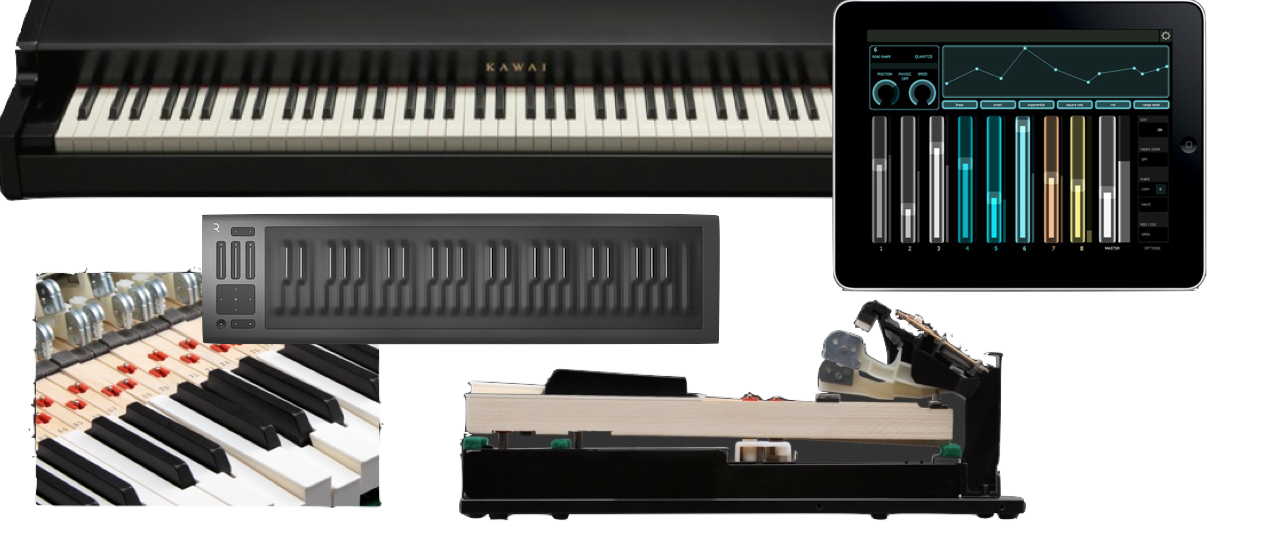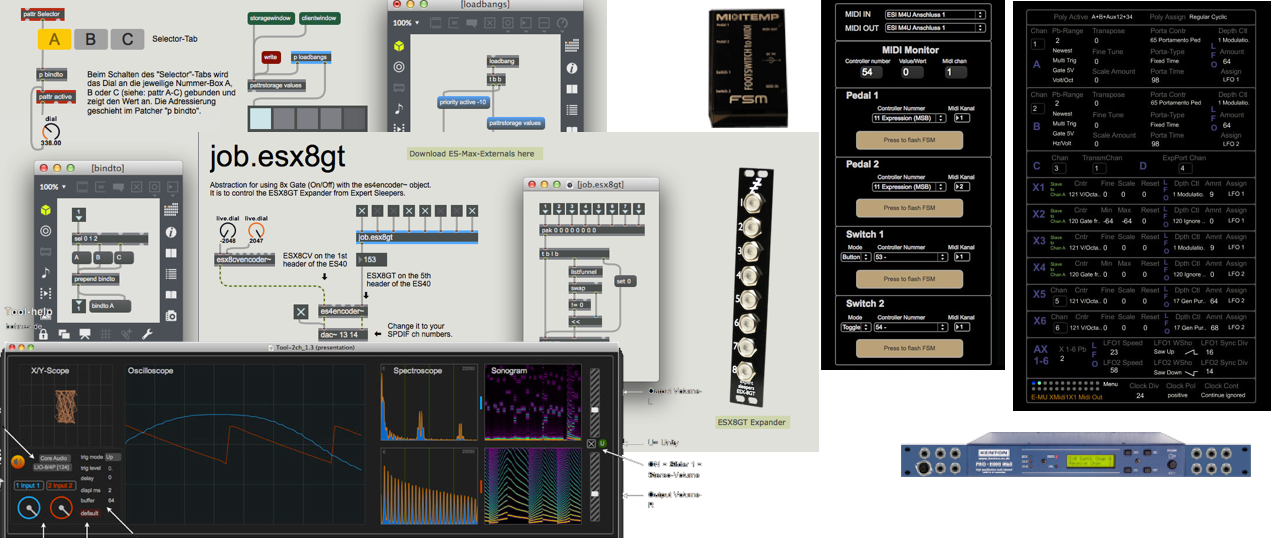In 1987 Peppino Di Giugno, co-founder of IRCAM in Paris in 1975 (together with Luciano Berio and Pierre Boulez), agreed on a contract to direct the development of the M.A.R.S. (Musical Audio Research Station) at Studio IRIS, a FARFISA Research Institute in Paliano (about 60 km from Rome, Italy). The project was financed by the Bontempi-Farfisa Group. The background for this research project was quite serious: it was about nothing less than saving the badly battered Italian electronic music instrument industry. After a period of prosperity, a leading position in Europe in this field was lost with the advent of digital electronics. The M.A.R.S. became an open architecture to develop applications that would eventually be used in sound chips of modern instruments to end the crisis and turn the tide for the manufacturers.
 With Di Giugno, "the" Italian genius par excellence in this field had been gained for this task. His 4X computer, which he had developed at (or for) IRCAM, set new standards in the 1980s. Di Giugno's vision was "to design a computer musical instrument with characteristics of universality, independent of the process of technological development and the evolution of musical thought." Together with an excellent team, the work began at IRIS in Paliano. My contacts were mainly Sylviane Sapir and Paolo Andrenacci, both of whom impressed me considerably. The biggest difference to IRCAM and France was certainly that there was significantly less money involved. In my opinion, Italy was therefore the ideal country for this project. The atmosphere was always very friendly and very focused. Curious: a top restaurant located directly next to the studio, which attracted mainly well-heeled Romans in the evening (which was clearly visible from the posh cars parked in the evening), functioned during the day (until 6 p.m.) as a "canteen" for the employees and guests of IRIS. Food and atmosphere were delicious! Italy - a culturally rich country!
With Di Giugno, "the" Italian genius par excellence in this field had been gained for this task. His 4X computer, which he had developed at (or for) IRCAM, set new standards in the 1980s. Di Giugno's vision was "to design a computer musical instrument with characteristics of universality, independent of the process of technological development and the evolution of musical thought." Together with an excellent team, the work began at IRIS in Paliano. My contacts were mainly Sylviane Sapir and Paolo Andrenacci, both of whom impressed me considerably. The biggest difference to IRCAM and France was certainly that there was significantly less money involved. In my opinion, Italy was therefore the ideal country for this project. The atmosphere was always very friendly and very focused. Curious: a top restaurant located directly next to the studio, which attracted mainly well-heeled Romans in the evening (which was clearly visible from the posh cars parked in the evening), functioned during the day (until 6 p.m.) as a "canteen" for the employees and guests of IRIS. Food and atmosphere were delicious! Italy - a culturally rich country!
It was probably the most unique project I have ever been a part of. Working with M.A.R.S. was like being 15 to 20 years ahead of the times. The sounds blew the minds of those in attendance. Everything was new and some of the synthesis forms were previously unheard.
M.A.R.S.
MARS derives from the MUSICn philosophy, since it retains the basic approach developed by Max Mathews [Mathews et al. 1969]. The synthesis algorithms are specified as combinations of building blocks; the activation of instruments is controlled by note events. Indeed, this historical background is also found in the main features of the 4X system [Favreau et al. 1986] (high-performance real-time sound processing and interactivity) and in the general GROOVE concepts of controlling note parameters by time functions during performance [Mathews, Moore 1970]. The emphasis is on symbolic representation of data in order to provide a user interface that is independent of the hardware architecture, making musical applications portable.
M.A.R.S. Mk I
The M.A.R.S. is a traditional three-stage system (DSP, controller and host). The IRIS X20 digital signal processor is dedicated to real-time sound processing [Cavaliere et al. 1992]. The Motorola MC68302 microcontroller supports the RT20M real-time operating system [Andrenacci et al. 1992] developed for the NERGAL sound generation board. The host computer carries support for the ARES graphical development environment.
This architecture guarantees high performance and offers the possibility to distinguish between sound processing and performance control, so musicians can also use MARS as a MIDI instrument (= in absence of the host computer).

In 1992 the first hardware version of the M.A.R.S. was introduced and in January 1995 the M.A.R.S. reached market launch.
Until the end of 1996 the host computer was an ATARI with the software Edit20 [IRIS] and in January 1997 the computer platform switched from ATARI to Windows PC. The connection to the computer was now made via ISA card in the bus board of the PC. The new software ARES (Audio Resource Editing System) represented a quantum leap for the programming.
ARES
Software (Windows 3. and Win95)

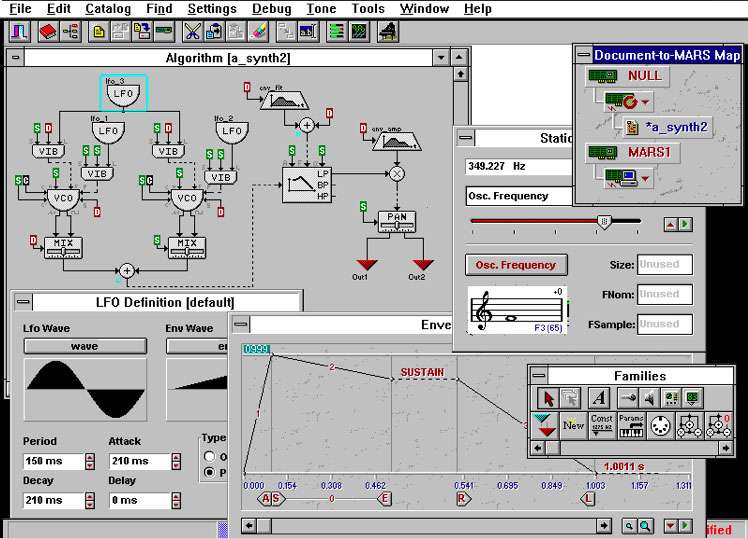 MARS features a predefined set of simple objects that can be edited with the ARES graphical environment in order to create more complex objects such as "Algorithms", "Tones", "Orchestras" and MIDI performance setups. The basic MARS audio objects are user patchable algorithms that correspond to specific signal processing operations (microcode for the X20 chip). The "Algorithms" are created graphically and are implemented immediately on the sound generation board, thus no compilation time is required.
MARS features a predefined set of simple objects that can be edited with the ARES graphical environment in order to create more complex objects such as "Algorithms", "Tones", "Orchestras" and MIDI performance setups. The basic MARS audio objects are user patchable algorithms that correspond to specific signal processing operations (microcode for the X20 chip). The "Algorithms" are created graphically and are implemented immediately on the sound generation board, thus no compilation time is required.
Each "algorithm" allows the user to configure a number of "tones". A "Tone" defines for all "Algorithm" parameters the rules for calculating their values and their relationship to MIDI controls and events..
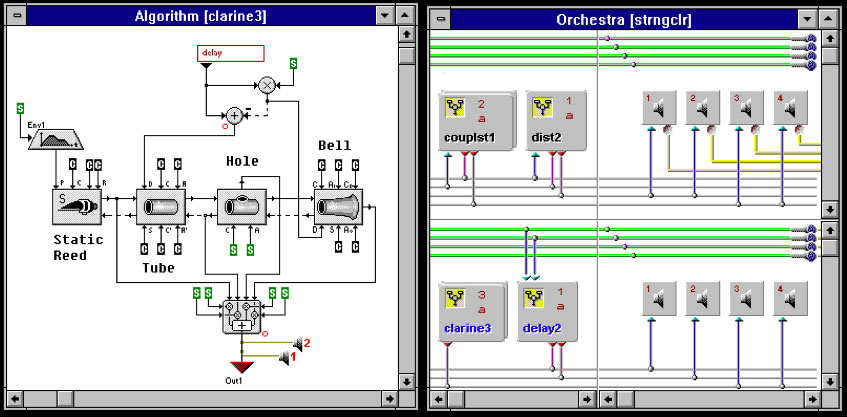 An "Orchestra" is a collection of polyphonic algorithms (clones) and an association of their interconnection with audio buses, DACs and ADCs. For each "Orchestra", the user can create a set of sound settings that define the set of "Tones" to be played and the overall MIDI environment of the "Orchestra", also called the performance environment.
An "Orchestra" is a collection of polyphonic algorithms (clones) and an association of their interconnection with audio buses, DACs and ADCs. For each "Orchestra", the user can create a set of sound settings that define the set of "Tones" to be played and the overall MIDI environment of the "Orchestra", also called the performance environment.
The creation and the editing steps of these objects include different domains managed by different processors. For example, the output data of an "Algorithm" or "Orchestra"- affects the DSP level (X20 microprograms, data memory values, sample memory, ...), while the output data of a "Tone" or an editing of the "Tone" involves the control level (i.e. the operating system running on the microcontroller) that manages the MIDI messages and the interactions of the performance environment.
Operation
Working on the MARS is usually done in three steps [Favreau, Sapir 1993]. The order of the steps is not a strict necessity, on the contrary, many processing steps can be performed in parallel, which increases the flexibility of the system.
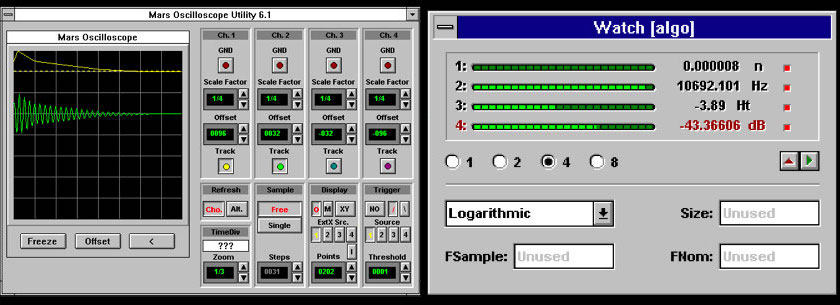 The first step is to create and debug "algorithms" using the Algorithm Editor [Armani et al. 1992] for processing signals: synthesis, analysis and effects. This system provides the user with a rich and extensible library of patchable modules for signal processing and a set of debugging tools (oscilloscope, VU meter, etc.) that simplify the creation and debugging of algorithms. In addition, the system implements the modules in real time as soon as they are installed by the user.
The first step is to create and debug "algorithms" using the Algorithm Editor [Armani et al. 1992] for processing signals: synthesis, analysis and effects. This system provides the user with a rich and extensible library of patchable modules for signal processing and a set of debugging tools (oscilloscope, VU meter, etc.) that simplify the creation and debugging of algorithms. In addition, the system implements the modules in real time as soon as they are installed by the user.
 The second step is the creation and the debugging of timbres [Palmieri, Sapir 1992] with the Tone Editor: defining values and the rules for calculating the parameters of the previously defined algorithms. Each algorithm can be configured with a series of "tones" (defining its parameter values, envelopes and waveforms, as well as assigning and defining MIDI control parameters, etc.) using a series of secondary editors and graphically interactive tools, all part of the ARES package.
The second step is the creation and the debugging of timbres [Palmieri, Sapir 1992] with the Tone Editor: defining values and the rules for calculating the parameters of the previously defined algorithms. Each algorithm can be configured with a series of "tones" (defining its parameter values, envelopes and waveforms, as well as assigning and defining MIDI control parameters, etc.) using a series of secondary editors and graphically interactive tools, all part of the ARES package.
The third step is to create and debug the "Orchestra" using the Orchestra and Tone Map editors: Listing the algorithms and timbres to be used and defining the MIDI performance environment associated with the Orchestra. During development of new algorithms and timbres, the user creates a kind of database of sound resources that can later be used in one or more orchestras for music performance. These orchestras can be considered as real performance environments once the user has defined the polyphony of the different algorithms used, the list of timbres to be played, the assignment of MIDI channels and finally the configuration of the audio buss.
Once these three phases are completed, the MARS can be used for live music by connecting it to a gesture MIDI controller or MAX application [Puckette 1991].
My M.A.R.S.
The simple reason for my fondness of the 19-inch M.A.R.S., apart from the phenomenal sound, was that configurations created with the host computer could also be saved as a MIDI file, and that MIDI file could be integrated into the MAX patch created for it, in turn, and simply sent to the M.A.R.S. as a MIDI dump after opening the MAX patch - so: open Max patch, click MIDI dump button, play. This capability made the system the lightest and most transportable system of its time, since the host computer on which the applications had been programmed could remain at home or in the studio during performances, and the M.A.R.S. could be transformed into completely different audio processors simply by dumping MIDI, even during concerts. This version of the M.A.R.S. is absolutely silent, as it has no fans, and it is lightweight! A musical instrument that came in an elegant leather imitation case.
Besides me, there were only a handful of private individuals who possessed a M.A.R.S..
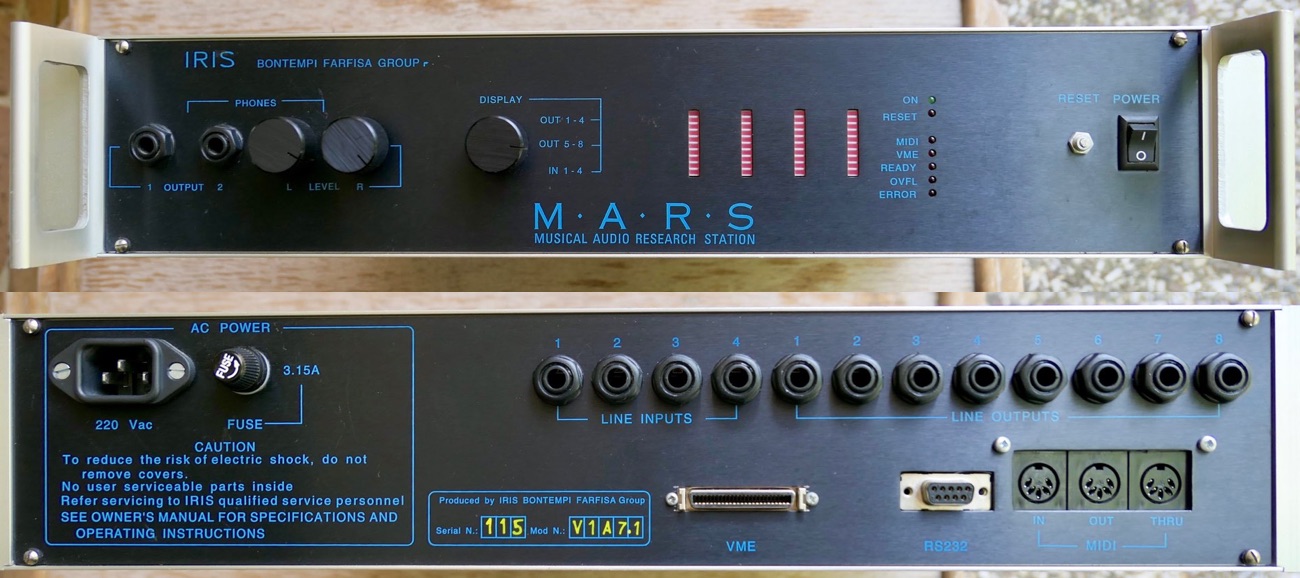
 A glimpse at the well-sorted inner organs of the M.A.R.S.: Somewhat below the center, the IRIS X20 signal processor can be seen.
A glimpse at the well-sorted inner organs of the M.A.R.S.: Somewhat below the center, the IRIS X20 signal processor can be seen.
The possibilities offered were simply unimaginable even as such and to this extent, in this compact casing before.
The MIDI integration and the GUI (Graphical User Interface) I used to program with the "Programming Environment" MAX - first on an Apple SE30, since 1995 on an Apple 540c, the first Apple laptop with color display. Thus, with M.A.R.S. and computer, I could already make airplane trips with the complete instrument as hand luggage. Encouraging! The majority of the audience had never heard sounds like realtime sampling, granular synthesis, physical modeling, etc. before.
My M.A.R.S. was given a bus upgrade in 1998. During a visit to Paliano because of converter problems, besides the free replacement of all converters, my M.A.R.S. was kindly modernized at the same time. Now it no longer had 2x 4 outputs (buses separated from each other), but 1x 8 outputs. An annoying limitation was thus out of the way! I think I am the only "customer" who got this - there was just the generation change to the ISA cards coming up, which was also linked to another hardware, and the Studio IRIS should only exist for a few more months.
A photograph of my domicile during the 90s. This is where I learned about MAX, M.A.R.S., C programming and much more. All these historical computers!

M.A.R.S. Mk II
In 1998 the biggest upgrade of the M.A.R.S. finally came, being now an ISA card, for installation into the PC. With the ISA card also came an external 19 inch audio I/O unit with 8x analog I/O and 8x digital I/O (AES-EBU) was introduced.
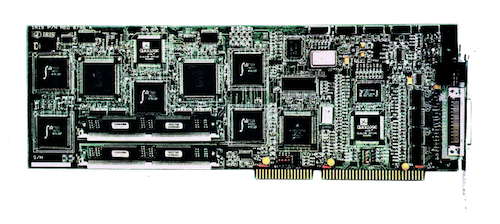
 The ISA card brought technical advancements:
The ISA card brought technical advancements:
The sampling frequency was now adjustable between 32 and 44.1kHz - before it was fixed at 39.0625 kHz. The biggest change, however, was that the M.A.R.S. ISA-Card could now be equipped with 64MB sample RAM instead of 32MB, and that up to eight M.A.R.S. ISA-Cards could now be operated in one computer - i.e. up to 512MB RAM.
I have encountered this generation, which was supposed to be the last generation, only once in the "Experimental Studio of the SWF" ("Strobel Foundation") during the configuration of the freshly acquired M.A.R.S. MkII. As impressive as the technical progress was - this version was no longer " my cup of tea".
Above all, I didn't appreciate this change because PCs were bulky and weighty back then, and the fans made a hell of a lot of noise. The (easy) transportability was also gone. It was now also no longer an "all-in-one system". But that's exactly why I decided to buy my own M.A.R.S. in 1994.
Now that M.A.R.S. was a card in the PC, it meant that the PC always had to be running to work with M.A.R.S.. Now it had become more of a system for studios with machine rooms and soundproof cabinets. As a result, this new M.A.R.S. lost the status of a musical instrument for me and became a, rather unpleasant "apparatus".
I expect a musical instrument to be silent when I'm not doing anything. I therefore abandoned the innovations and remained happy with my lightweight 2U 19 inch instrument. In any case, I probably could hardly have paid for this conversion (but never asked the price). I much preferred the old version because of its advantages - even with just 32Mb RAM!
As little as I understand about technology, I also had doubts about the transformation. Why ISA (16bit) again? ISA was an interface that was already 20 years old and PCI (32bit) was on the horizon and spreading rapidly. Apple offered computers with PCI interface since 1995 already and in the, fast changing computer world it was foreseeable that the ISA bus will not have a bright future any more.
The end of IRIS
In 1999, the IRIS studio had suddenly "disappeared". Just like that, closed without any notice. No messages, no legacies, no documents, no spare parts or technicians who could have repaired the M.A.R.S., no addresses, no phone numbers. It had been a real shock! Even in the still new "Word Wide Web": NOTHING!
Since almost all customers of M.A.R.S. were universities or studios (financed with public or foundation funds) and were in (a rather idiotic) competition among each other instead of going forward with each other, there was little interaction among the "owners" and there was no ambition to save this platform together over time. After all, it was "public money" that had been invested or rather lost - of course the "users" didn't realize that, so no thought was given to it.
The Electronic Studio of the Music-Academy Basel
I had been introduced to M.A.R.S. in the electronic studio of the "Akademie Basel", with which I had been increasingly connected since 1993, and namely through Thomas Kessler, composer, director and founder of the studio. As a "composer's studio", the Basel studio was one of the few places where the composers' musical wishes and ideas for the realization of electronics in their works were individually implemented - and Thomas Kessler had brought a pre-version of the M.A.R.S. to the studio, which was "researched" with great interest, here Wolfgang Heiniger, Thomas Kessler's assistant, was the driving force and already familiar with DSP through his previous stay in Stanford/USA.

By autumn 1994 - we had become familiar with the M.A.R.S. and already realized several projects with it - when the announcement was received that the M.A.R.S. would soon be ready for the market, two units were ordered by the studio. The M.A.R.S. was simply a warrant for so many things that wouldn't have been possible without M.A.R.S.!
Since I was no student or lecturer in Basel ( perhaps a bit of both) and because I didn't want to tie my activity to the few places (studios) equipped with a M.A.R.S., I decided after a short consideration to sell all my Yamaha and ARP synthesizers plus some equipment in favor of an owned M.A.R.S.. A decision with clear consequences, but one that I have never regretted. The M.A.R.S. finally amounted to 15 million Lire (approx. 15,000 DM)! THAT'S insanity! So, for me, a third M.A.R.S. was added to the order and Basel therefore became, in 1995, practically over night and at least north of the Alps, the largest M.A.R.S. Representation on earth.
 By now Wolfgang and I had started working on a real-time sampler - there was nothing like that at that time. During this period I have learned a lot from Wolfgang. If I didn't knew how to solve a problem, he had a solution in mind, although sometimes it took weeks. The realtime sampler (with filters, ring modulation, etc.) became an instrument that gave us a kind of unique position for a while and which we were also envied for. In the course of a MAX interview, the Realtime Sampler was even mentioned in the "KEYS Magazine" - including a short "track" of mine as a sound sample on the attached CD.
By now Wolfgang and I had started working on a real-time sampler - there was nothing like that at that time. During this period I have learned a lot from Wolfgang. If I didn't knew how to solve a problem, he had a solution in mind, although sometimes it took weeks. The realtime sampler (with filters, ring modulation, etc.) became an instrument that gave us a kind of unique position for a while and which we were also envied for. In the course of a MAX interview, the Realtime Sampler was even mentioned in the "KEYS Magazine" - including a short "track" of mine as a sound sample on the attached CD.
The M.A.R.S. sounded so good that Karlheinz Stockhausen, during a visit to the studio in Basel, for which we had programmed various ring modulators for him to choose from for an upcoming performance of "Mixtur" (with the M.A.R.S.), said after listening that they were "just as good as the old, analog ring modulators at WDR, except that they make less noise". Anyone who has even the slightest idea of Karlheinz Stockhausen's relationship to his old ring modulators might have an idea of what that meant! The M.A.R.S. was knighted! The other titan, Luciano Berio, also occasionally worked with the M.A.R.S. on his own works at the IRIS Studio in Paliano, and I was incredibly fortunate to have witnessed and worked musically with both of them.
In the following years, we actually did everything "important" with the M.A.R.S. at the Studio in Basel, and not only composed music was performed - after all, my background is in improvisation - and that was of course a great challenge as well!
Setup
Quasi with getting the M.A.R.S., 1995, it took over the central role in my professional living and also triggered big changes in my entire life. It felt very good to no longer be bound to the aesthetic or functional decisions of the manufacturers (and to abuse synthesizers and samplers with SysEx data)! Now I could make all the decisions myself. With M.A.R.S., the DSP structure and, with MAX, the MIDI control and everything that concerned musical decisions could be programmed all by myself. It was an almost heavenly state! And I was the only musician who also "tingled" with a M.A.R.S.. The doors stood wide open - sometimes I even spontaneously joined a third set at a friend's concert. Everything was extremely uncomplicated and the backpack was small!
 Since the M.A.R.S. has no microphone preamps, I used a small Mackie mixer and fed the microphone signals (max. 4) as "Direct Out" straight into the line inputs of the M.A.R.S..
Since the M.A.R.S. has no microphone preamps, I used a small Mackie mixer and fed the microphone signals (max. 4) as "Direct Out" straight into the line inputs of the M.A.R.S..
This way, I could already provide stage amplification for voices or acoustic instruments at smaller concerts, because the unprocessed signal could also be routed to the outputs of the mixing console. For larger ensembles I still had a larger Mackie mixing desk.
In this photo a slightly larger setup with an analog Sherman filterbank is shown: The photo was taken in La Jolla, San Diego, USA in 1999. It is hard to convey today how much freedom the M.A.R.S. meant back then! For such a complex electronics at that time normally rather the use of a low-loader would have been required!
 An additional speed-up in setting up and disassembling was achieved using my wireless microphone system of the "SONY Freedom Series" with lavalier (miniature) microphones. This, too, was like a thing of the future at the time. The transmitter (left) and receiver (right) were smaller than today's smartphones and had a considerable range. They worked smoothly. It was a set from the TV segment.
An additional speed-up in setting up and disassembling was achieved using my wireless microphone system of the "SONY Freedom Series" with lavalier (miniature) microphones. This, too, was like a thing of the future at the time. The transmitter (left) and receiver (right) were smaller than today's smartphones and had a considerable range. They worked smoothly. It was a set from the TV segment.
summa summarum:
a super-small, very lightweight, very good-sounding live electronics setup that I could program entirely on my own, but also carry - and set-up and take-down only required a couple of minutes. It has never been better!
Feldberg - @ Museum of Art, Balboa Park, San Diego, USA 1999
Jochen Rückert- dr; Hayden Chisholm - as; Jochen Bohnes - M.A.R.S. and Sherman Filterbank.
Along with the end of IRIS and the disappearance of the studio in Paliano also came the detachment from the studio in Basel in 1999. The 5 years with my M.A.R.S. had been a "game changer". MAX and MARS had opened many new doors to me during the past 10 years, I had been able to work or / and play with some of the great composers alive and the step from jazz piano into the "uncertain world of computers" and into digital electronics in contemporary music, had been taken.
After moving to London, I was forced to carry the M.A.R.S. more often as carry-on luggage, and I temporarily, but unwillingly, got used to traveling by plane. Thus it went two times to the USA. There, after a concert, I met Miller Puckette, the "inventor" of MAX. Miller is also a real genius and one of the most wonderful personalities I have ever met!
During my period in London, I had the PC "on the continent" and had not programmed any new configurations on the M.A.R.S.. I was able to use my existing M.A.R.S. patches (and at that time I actually intended to play more and program less). After 9/11, I couldn't find any willingness to be humiliated at airports for security reasons and moved back to "the continent". However, even then I didn't start any new projects with M.A.R.S. because the worry grew that I would lose all my work if M.A.R.S. broke down. A really bad feeling. MAX became significantly better and more versatile, Firewire audio interfaces arrived in 2001, and things took their own turn. M.A.R.S. found itself "fading out" in my life due to circumstances - although I still thought it was just as good as it was on the first day. In the meantime, MAX can do even more in audio, especially with Gen, in some areas (not all!) than the M.A.R.S. ever could - but I often think of the M.A.R.S. and somehow believe it was far superior in terms of sonic performance.
… then that:



